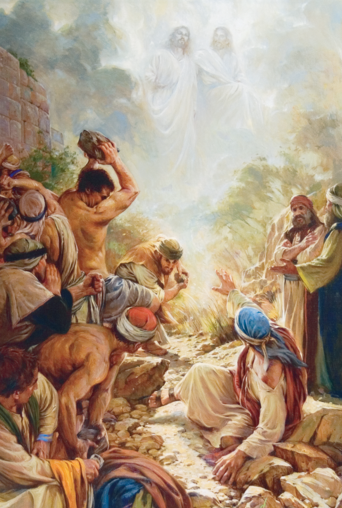Chronology 13: Second half of the 70th week of years
10-02-2016 - Posted by Andre PietThe half week of years… in Aviv / Nisan
Daniel 9:27 refers to the Messiah, who would put an end to sacrifice and approach present. Earlier we saw that this was fulfilled when Jesus Christ died during the evening approach present (the ninth hour) and completed the offering service; He literally let it end. The huge curtain of the temple was rent in two from above to the bottom. From God the offering service that was carried out at that moment was subverted thoroughly. All offerings under the old covenant were unnecessary as from that moment. But there is another detail about the point of time to report. For since a Hebrew new year begins in the month Tisri (cp Ex.34:24; Ex.23:16) half of the year falls (and thus also half of the year week) six months later. That is in the month of Aviv (Nisan), that is the month of Pesach. According to the prophesy of Daniel 9 during this month the Messiah would end sacrifice and approach present. And as we know from the New Testament Jesus actually died on the day of Pascha. An unmistakable confirmation of Daniel 9:27! 
The second half of the 70th week of years
The Messiah would confirm a covenant for Daniel’s people and the holy city, for one week of years. At the time of his death three and a half years had passed. But of course another three and a half years would also follow. That implicitly says that the Messiah would also rise. Otherwise He couldn’t be able to confirm the covenant another three and a half years. The book of Acts starts with this statement:
1 The first account, indeed, I make, O Theophilus, concerning all which Jesus begins both to do and to teach, 2 until the day on which He was taken up…
The first book was about what Jesus had begun to do. In other words: the second book is about the continuation of what Jesus did. Miraculous signs are attributed to Jesus because of that (2:33; 3:16; 4:10) As Mark 16 shows:
19 The Lord, indeed, then, after speaking with them, was taken up into heaven and is seated at the right hand of God. 20 Now they, coming away, herald everywhere, the Lord working together with them and confirming the word by the signs following them up.
About this confirmation through miracles and signs among the Jewish people and Jerusalem is written elaborately in chapter 1 to 6 of the book of Acts (2:43; 4:30; 5:12) About Stephen we read that he ‘did great miracles and signs among the people’ (6:8). When because of a lot of opposition he was brought to the Sanhedrin (the official representative of the Jewish people; 6:12) Stephen holds an impassioned plea (7:1-53) and he calls them ‘traitors and murderers’ of the Messiah. Stephen’s words hurt their feelings and the members of the Sanhedrin bring him outside the city and stone him. With this crime the Sanhedrin crucified the Son of God again (cp Hebrews 6:6). Now they are no longer ‘in ignorance’ (Acts 3:17), but they are fully aware. Officially the Jewish people and Jerusalem rejected with this act the Evangel of the resurrected Messiah. It is from this moment that the covenant for the Jewish people and for Jerusalem ends abruptly. No miracles and signs happen among the people and in Jerusalem any longer. A remarkable detail is that, just before his stoning, Stephen declares seeing ‘the Son of Mankind standing at the right hand of God’. Not in the sitting position as it is called elsewhere, but standing. It reflects a special moment, a milestone. It marks the end of a period. The confirmation of the covenant since Jesus’ baptism in the Jordan till his crucifixion and then till the death of Stephen, lasted a total of two times three and a half years.
Prophecy more detailed than historical description
It is extraordinarily remarkable that we are informed from Daniel 9 with so much precision about periods and moments which from historical description are much more vague. Thus, the seven weeks of years, in Daniel 9 reserved for the rebuilding of Jerusalem perfectly correspond with the information from Ezra and Nehemiah, but only Daniel makes prior notice of the exact time. The same occurs when we talk about the duration of Jesus’ public ministry. In general one assumes a period of more than three years, but only because of Daniel we know that it was three and a half years. So almost 500 years before God made Daniel record this with more finesse than the historians did afterwards! Also it is not possible to determine the length of the period from Jesus’ crucifixion to the stoning of Stephen precisely by the historical description of the book of Acts. Usually it is thought that the time span is two to four years. Only from Daniel 9 we know: it took three and a half years. God foretells the future with a precision as if it has already happened.
The end of the 70 weeks of years
The death of Stephen and thus the official rejection of the Evangel by Jerusalem is the end of the 70th sabbatical since Cyrus proclaimed to rebuild Jerusalem. The 500th year began.  This 500th year since Cyrus is again an extraordinary sabbatical. Because it is the year 4000 since Adam. Twice 2000 years have passed. A new period of 2000 years will begin. A period in which the name of a young man, mentioned for the first time at the stoning of Stephen, will play a major role (Acts 7:58). Very soon (the same year?) this fanatical adversary of Jesus would be called. Saul of Tarsus…
This 500th year since Cyrus is again an extraordinary sabbatical. Because it is the year 4000 since Adam. Twice 2000 years have passed. A new period of 2000 years will begin. A period in which the name of a young man, mentioned for the first time at the stoning of Stephen, will play a major role (Acts 7:58). Very soon (the same year?) this fanatical adversary of Jesus would be called. Saul of Tarsus… 
![]() HB
HB

 English Blog
English Blog
